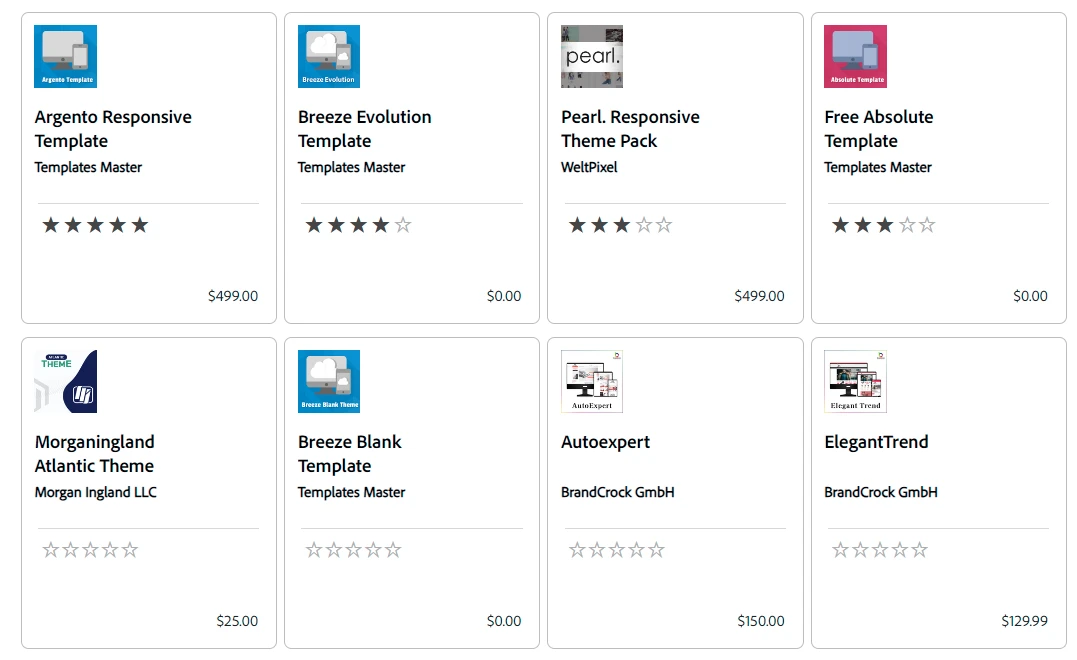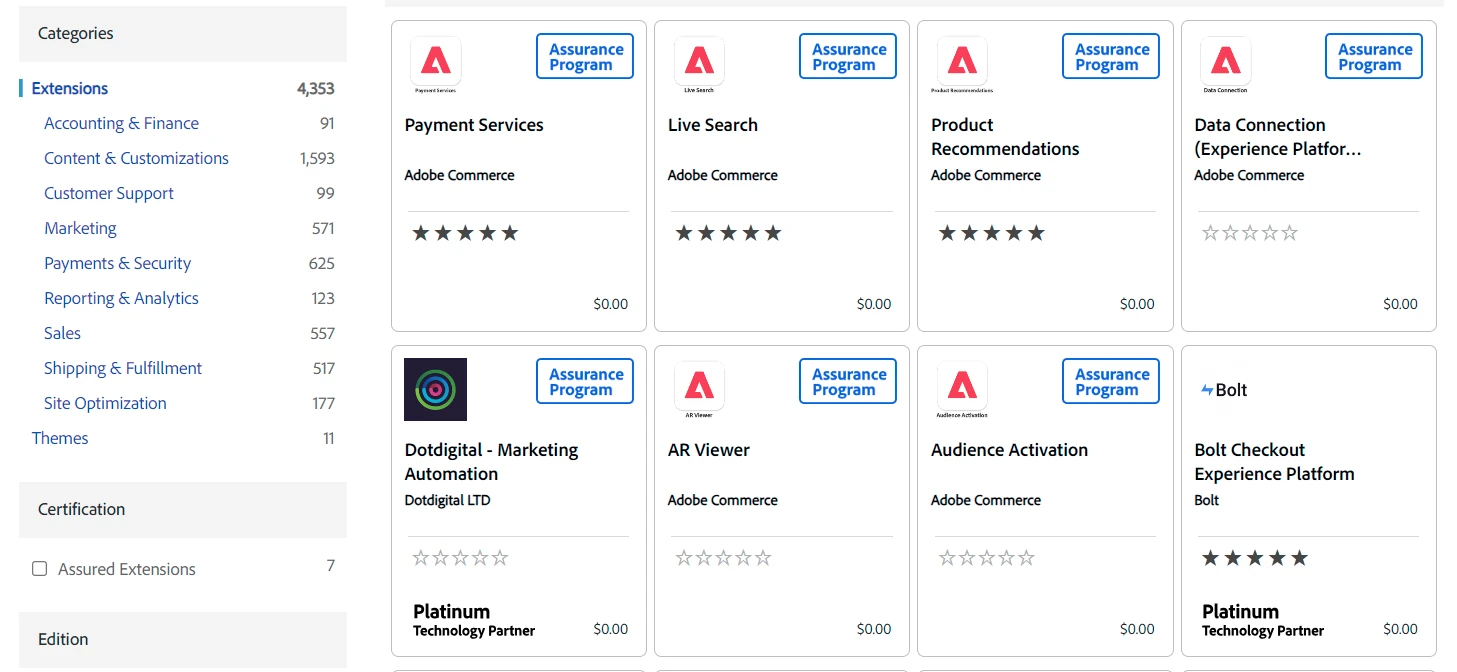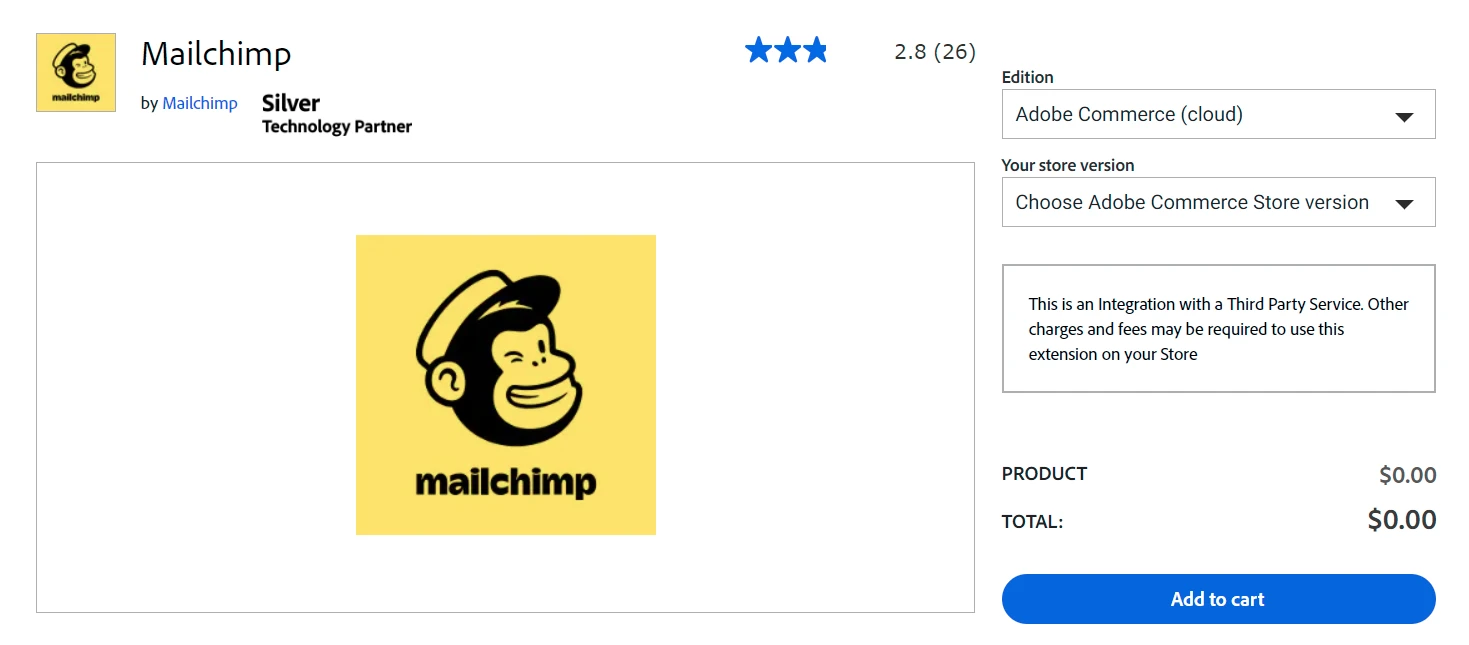As businesses increasingly seek flexible and scalable eCommerce platforms, Adobe Commerce continues to stand out as a leading solution for mid-sized to enterprise-level brands. However, with recent changes to its deployment models, many are now asking: How much is Adobe Commerce pricing in 2025?
Following announcements made at the Adobe Summit in 2025, Adobe Commerce has transitioned to a cloud-first approach, introducing a soon-to-be launched SaaS model and storefront optimization tools powered by AI. If you're planning to launch or scale your eCommerce business with Adobe Commerce, understanding the updated pricing structure is essential.
In this article, we'll cover:
- What Adobe Commerce is in 2025
- Adobe’s latest product packaging: SaaS, PaaS, Optimizer
- Cost structure and pricing breakdowns
- Key factors influencing total investment
Let’s explore Adobe Commerce pricing step by step, so you can choose the best model for your business growth.
What is Adobe Commerce?
Adobe Commerce (formerly Magento Commerce) is Adobe’s enterprise-grade eCommerce platform designed to support both B2C and B2B businesses. It provides robust tools for product management, order workflows, customer segmentation, promotions, omnichannel experiences, and extensibility—all within a single, powerful commerce engine.

In 2025, Adobe Commerce has continued to evolve beyond its open-source roots. While Magento Open Source still exists as a self-managed option, Adobe Commerce now focuses on cloud-native, enterprise-ready solutions. These are built to offer performance, personalization, and scalability—all aligned with Adobe’s Experience Cloud ecosystem.
Adobe has officially shifted its commerce strategy toward cloud-based deployment models. As of April 2025:
- On-premises deployments are no longer highlighted on Adobe’s pricing page. While technically still supported under legacy agreements, they are no longer the focus of Adobe's product roadmap.
- Managed Service, which once offered high-touch hosting and infrastructure management, has also been phased out of public packaging in favor of a more streamlined, scalable model.
Instead, Adobe’s 2025 product lineup now revolves around three core offerings:
- Adobe Commerce as a Cloud Service (SaaS) – Fully multi-tenant, versionless, auto-updating.
- Adobe Commerce on Cloud (PaaS) – Single-tenant, flexible, infrastructure-controlled.
- Adobe Commerce Optimizer – A headless storefront and merchandising layer that plugs into any backend.
This shift aligns Adobe Commerce with modern eCommerce expectations: speed, flexibility, composability, and AI-driven experiences.
How Many Adobe Commerce Pricing Packages?
As of 2025, Adobe Commerce offers three official product packages, each tailored to different technical needs and business sizes. These packages reflect Adobe’s shift toward a modular, cloud-first commerce strategy, replacing older models like on-premises or Managed Services with more scalable, API-driven solutions.

Let’s take a closer look at each option!
1. Adobe Commerce as a Cloud Service (SaaS)
This is Adobe’s newest and most ambitious offering, expected to launch in June 2025. Adobe Commerce as a Cloud Service (ACCS) is a fully managed, multi-tenant SaaS platform, designed to simplify deployment, eliminate manual upgrades, and deliver faster performance out of the box.
Key features:
- Versionless SaaS with automatic updates
- Multi-tenant architecture with global scalability
- Built-in personalization, promotions, AI-driven merchandising
- Add-ons available for digital storefront, content authoring, and experimentation
- Integrates seamlessly with Adobe Experience Cloud (Firefly, Express, etc.)
Best for: Businesses looking for speed, simplicity, and hands-off infrastructure.
2. Adobe Commerce on Cloud (PaaS)
This Platform-as-a-Service (PaaS) model provides dedicated, single-tenant cloud infrastructure, ideal for companies that require full control over their environment, deeper customization, and robust integration capabilities.
Key features:
- Hosted on Adobe’s cloud (usually AWS or Azure)
- Full codebase access and extensibility
- Support for complex B2B workflows, international stores, and advanced APIs
- Add-on options for storefront, content tools, and analytics
- PCI and SOC2 compliance, 24/7 support, CI/CD pipelines
Best suited for Businesses with internal development teams, complex workflows, or existing infrastructure preferences.
3. Adobe Commerce Optimizer
Adobe Commerce Optimizer is a headless, modular solution designed to enhance storefronts and merchandising for businesses using Adobe or third-party backends.
It doesn’t replace your commerce engine—instead, it layers modern storefront capabilities on top of it. This package is expected to launch elsewhere in June 2025.
Key features:
- Lightning-fast storefront with excellent Lighthouse scores
- AI-generated content and personalized promotions
- Content authoring, A/B testing, experimentation tools
- Built for composable and headless commerce environments
Best for: Businesses with an existing backend who want to modernize their frontend experience.
Each package is offered under a custom pricing model, based on your business's gross merchandise value (GMV), average order value, infrastructure needs, and usage tier. Adobe’s team provides quotes upon request.
Adobe Commerce Pricing: How Much Does It Cost?
When building an Adobe Commerce store in 2025, merchants must budget for several types of costs — some mandatory, others optional, depending on business needs. Understanding Adobe Commerce pricing today means recognizing the move toward new cloud-native models and modular commerce solutions.
Adobe’s current pricing is quote-based, customized primarily by:
- Annual Gross Merchandise Value (GMV)
- Average Order Value (AOV)
- Selected product package (SaaS, PaaS, or Optimizer)
- Infrastructure, customization, and add-on usage
Update (April 2025): Adobe Commerce pricing structures were updated following the Adobe Summit 2025. While Adobe doesn’t publish exact pricing, based on historical benchmarks and industry sources, here’s what merchants can expect:
Types of costs | Estimated price |
Annual cost | |
Mandatory license fees | $22,000 – $125,000+ per year (based on GMV/AOV) |
Hosting infrastructure | Included in SaaS & PaaS (external for on-prem) |
Development & maintenance | $10 – $200/hour, or up to $120,000/year (agency/in-house) |
SEO & marketing tools | $25 – $1,200+ per year (plugins, integrations) |
Optional/One-time costs | |
Domain name | $10 – $20/year |
Themes | $0 – $499 (depending on design needs) |
Extensions (modules) | $0 – $100,000 (based on functionality required) |
In general, total pricing of Adobe Commerce can range from approximately $122,000 to over $ 450,000 per year, depending on the platform's complexity, store size, performance requirements, and level of customization.
- PaaS (Adobe Commerce on Cloud): Typically $40,000 – $200,000/year, including cloud hosting.
- SaaS (ACCS, launching June 2025): Expected to offer tiered, lower infrastructure costs, but official rates not yet disclosed.
- Optimizer: Modular pricing based on selected storefront and merchandising capabilities.
For exact costs tailored to your business, you should contact Adobe for a customized consultation.
7 Factors Affecting Adobe Commerce Pricing Estimations
1. License fees
As previously mentioned, license fees are a compulsory Adobe Commerce cost when selling on this platform. They’re estimated based on GMV and AOV: the higher your store’s average gross sales revenue, the more you need to pay.
For more information, let’s check Adobe Commerce’s license fee below.
Average Gross Sales Revenue | Adobe Magento Commerce Cost |
<$1,000,000 | $22,000/year |
$1,000,000 - $5,000,000 | $32,000/year |
$5,000,000 - $10,000,000 | $49,000/year |
$10,000,000 - $25,000,000 | $75,000/year |
$25,000,000+ | $125,000/year |
Estimated Adobe Commerce pricing for license fees: From $22,000 to $125,000/year.
2. Domain name
The domain name is the unique address that directs users to your Adobe Commerce store. After selecting your desired name, you can buy it from reliable providers like Domain.com or Google Domains.
However, currently, Google no longer offers new domains; thus, you can not get a new domain from this provider. Instead, you can register with Squarespace, which has been a new home to Google domains since September 2023.
Typically, you need to pay between $10 and $20 per year to maintain your domain, depending on your provider and its level of popularity.
Estimated Commerce pricing for domain name: $10 – $20.
3. Hosting service
Another important factor influencing Adobe Commerce pricing is the selection of hosting services. Hosting determines where your website’s database, media files, content, and catalogs are stored, directly affecting your store’s performance, speed, and reliability.
In 2025, Adobe Commerce provides two main hosting options, depending on the package you select, along with a third option for legacy setups. To ensure your store’s perfect performance, you need to select a high-quality hosting service. Currently, Adobe Commerce allows you to pick one of the 3 main options of web hosting, including:
- Adobe Commerce as a Cloud Service
- Adobe Commerce on Cloud (PaaS)
- External hosting services (for on-premise or special cases)
Adobe Commerce as a Cloud Service (SaaS)
Launching in June 2025, Adobe Commerce as a Cloud Service (ACCS) delivers a multi-tenant cloud architecture, fully managed by Adobe. This approach simplifies infrastructure management, providing automatic scaling, security patches, and versionless upgrades.
Key hosting features:
- Dedicated cloud instances (isolated per merchant)
- Customizable infrastructure and code access
- DevOps pipelines for deployments and staging
- Managed PCI compliance, backups, patching
The hosting cost is bundled with your PaaS license but varies based on traffic, resource use, and customizations.
You can refer to our Adobe Commerce Cloud review to learn more about this solution.
Adobe Commerce on Cloud (PaaS)
Adobe Commerce on Cloud (PaaS) delivers a powerful, single-tenant cloud infrastructure hosted by Adobe on leading providers like AWS and Microsoft Azure. This option gives businesses full access to customize their codebase, integrate with third-party systems, and optimize performance based on specific needs.
Unlike the upcoming SaaS model, PaaS hosting is dedicated to each merchant, providing more control over infrastructure configurations, DevOps workflows, and application tuning.

Key capabilities include:
- Dedicated cloud hosting (isolated from other merchants)
- Customization at the server and application level
- DevOps pipeline integration for CI/CD
- Scalable resources based on traffic and catalog size
Hosting fees are bundled with your Adobe Commerce on Cloud license, but final pricing varies depending on your store's size, performance requirements, and customizations.
Note: Adobe Commerce On-Premise, where businesses host their own servers, remains supported for legacy merchants; however, it is no longer a primary deployment focus.
External hosting services
While most new Adobe Commerce deployments are now hosted through Adobe’s cloud infrastructure (SaaS or PaaS), businesses operating Adobe Commerce On-Premise or hybrid setups may still opt for external hosting providers.
If you manage your own hosting environment, you’ll need to choose from common hosting types such as:
- Dedicated Server Hosting
- Cloud Hosting Providers (e.g., AWS, Google Cloud, Azure)
- Virtual Private Servers (VPS)
- Shared Hosting (not generally recommended for Adobe Commerce)
In our experience, VPS hosting offers a strong balance between flexibility, security, and cost-efficiency for Adobe Commerce On-Premise stores.

External hosting services typically cost between $10 and $850/month, depending on:
- Server specifications (CPU, RAM, bandwidth)
- Security features (SSL, backups, firewalls)
- Support levels (managed vs. unmanaged hosting)
- Data center locations (regional vs. global)
It's essential to verify that your chosen hosting service is fully compatible with Adobe Commerce's requirements, including PHP versions, database performance, and scalability standards.
Tip: As Adobe transitions toward SaaS-first solutions, merchants using external hosting for on-premises setups should plan ahead for future migration or modernization opportunities.
Estimated pricing for hosting services: Varied.
- Adobe Commerce as a Cloud Service (SaaS): Hosting is fully managed by Adobe, included in SaaS subscription pricing.
- Adobe Commerce on Cloud (PaaS): Dedicated hosting infrastructure managed by Adobe (single-tenant), included in PaaS licensing, with costs varying based on infrastructure scale and resource usage.
- External hosting services: Estimated $10 – $850/month. Merchant-managed hosting using VPS, dedicated servers, or public cloud providers.
4. Web store design/themes
A storefront with unique decoration and a well-structured interface is necessary to encourage visitors to shop. Fortunately, Adobe Commerce offers a wide range of website themes, priced from $25 to $499. Additionally, you can design a new template by using JavaScript or CSS.

Before purchasing or developing a new theme, always verify that it is fully compatible with your Adobe Commerce version (PaaS or SaaS), especially regarding codebase standards and mobile responsiveness.
Estimated pricing for themes: From $25 to $499.
5. Extension integration
The next concern related to Adobe Commerce pricing is the ability to integrate with extensions. Currently, Adobe Commerce offers thousands of third-party plugins to enhance various functions, including finance, shipping, and order fulfillment. To utilize these integrations, you must pay between $25 and $100,000 per download.
In 2025, the Adobe Commerce Marketplace offers over 4,000 extensions, ranging from free plugins to complex enterprise-grade solutions.

To save your budget, consider using free plugins on the Adobe Commerce Marketplace. Some outstanding solutions you should consider include Mailchimp, Stripe Payment, and Bolt Checkout Experience Platform, among others.
Estimated Adobe Commerce pricing for extensions: From $25 to $100,000.
6. Development and maintenance
When budgeting for Adobe Commerce, you cannot overlook development and ongoing maintenance costs. To stay competitive, merchants must ensure their websites are continuously optimized, secure, and scalable, which often requires technical expertise. Development and maintenance tasks may include:
- Custom theme or extension development
- API integrations
- Performance optimization
- Security patches and updates
- Storefront enhancements or Optimizer deployments
For merchants without an in-house technical team, working with professionals is strongly recommended. Below are three common development options you should consider for your store:
- Freelancer: $10 to $200 per hour;
- Web Development Agency: $25 to $200 per hour;
- In-house Development Team: $60,000 to $120,000 per year.
Tips: Agencies specializing in Adobe Commerce (including PaaS or SaaS deployments) can often provide structured packages for faster, safer launches, especially important if you plan to integrate Adobe Commerce Optimizer or transition toward SaaS models in the future.
Estimated Adobe Commerce pricing for development: Varied based on development options.
7. SEO & Marketing
To make your Adobe Commerce store outstanding on search engines, you should invest in marketing and SEO resources. Fortunately, there are hundreds of marketing and SEO plugins, both free and paid, to support your business needs. These cover various categories and needs, and the Commerce Marketplace features filters, allowing you to easily find what you need.

More importantly, you can integrate your store with top social platforms (Facebook, Instagram, Pinterest, etc.) and other sales channels to maximize your marketing performance. These third-party apps can cost anywhere from $25 to $1,200, depending on your specific needs. However, you need to clearly consider your requirements to select a suitable solution.
Estimated Adobe Commerce pricing for SEO & marketing: From $25 to $1200.
Adobe Commerce Pricing: FAQs
How much does Adobe Commerce cost annually?
Adobe Commerce pricing is customized based on your store’s Gross Merchandise Value (GMV), Average Order Value (AOV), and selected deployment model.
- License fees typically range from $22,000 to $125,000+ per year.
- For businesses choosing PaaS (Adobe Commerce on Cloud), total costs including hosting and infrastructure can fall between $40,000 to $200,000+ per year.
- Pricing for ACCS and Optimizer (launching June 2025) will also depend on usage tiers, but Adobe has not published official rates yet.
What is the difference between SaaS (ACCS) and PaaS (Adobe Commerce on Cloud)?
Adobe Commerce SaaS (ACCS) is a fully managed, multi-tenant platform with automatic updates and limited customization via APIs. Meanwhile, PaaS (Adobe Commerce on Cloud) provides a single-tenant environment with full code-level customization but requires merchants to manage patches and scaling.
SaaS suits simplicity; PaaS fits complex, customizable projects.
When will Adobe Commerce as a Cloud Service (ACCS) be available?
Adobe Commerce as a Cloud Service is scheduled for general availability in June 2025. It will be Adobe’s flagship SaaS offering, designed for faster launches, lower operational complexity, and future-proof scalability.
What is Adobe Commerce Optimizer?
Adobe Commerce Optimizer is a modular, headless storefront and merchandising solution designed to improve the frontend experience without necessitating a backend migration. It is compatible with Adobe Commerce PaaS as well as third-party commerce engines. Key features include personalized promotions, A/B testing, AI-driven content generation, and dynamic storefront capabilities.
Do I need to migrate if I'm currently using Adobe Commerce on Cloud?
No immediate migration is required. Adobe continues to support PaaS deployments. However, over the next few years, businesses are encouraged to consider phased adoption of Optimizer and ACCS to stay aligned with Adobe’s modernization roadmap and unlock future SaaS advantages.
Conclusion
Adobe Commerce’s pricing and packaging strategy has evolved significantly in 2025, reflecting broader shifts in the eCommerce world toward cloud-native, scalable, and AI-enhanced solutions. Today, merchants can choose among three streamlined packages:
- Adobe Commerce as a Cloud Service (ACCS) — a fully managed, multi-tenant SaaS solution launching in June 2025.
- Adobe Commerce on Cloud (PaaS) — a single-tenant, highly customizable cloud platform for businesses needing deeper control.
- Adobe Commerce Optimizer — a headless storefront solution to modernize customer experience without replatforming.
As Adobe transitions away from legacy models like On-Premise and Managed Services, future success with Adobe Commerce will depend on selecting the model that best fits your growth goals, technical flexibility needs, and operational resources.
LitExtension, the #1 eCommerce Migration Expert, hopes you have the best preparation for Adobe Commerce cost. Check out our Adobe Commerce articles or join our Facebook Community Group for more valuable insights.

